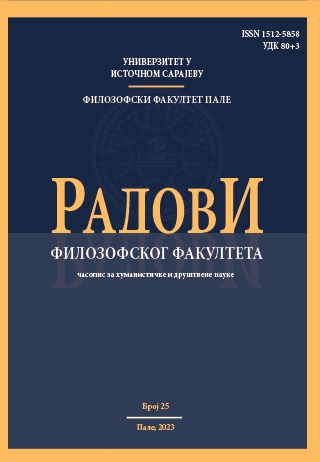ТИПОВИ ТУЂЕГ ГОВОРА У ПИСАЊУ СРБОФОНИХ ГОВОРНИКА НА ЕНГЛЕСКОМ
TYPES OF REPORTED SPEECH IN SERBIAN EFL STUDENTS’ WRITING IN ENGLISH
Author(s): Srđan R. ŠućurSubject(s): Foreign languages learning, Morphology, Syntax, Sociolinguistics, Higher Education
Published by: Универзитет у Источном Сарајеву, Филозофски факултет Пале
Keywords: reported speech; direct speech; indirect speech; reporting clauses; backshift; argumentative essays; Serbian EFL students;
Summary/Abstract: The use of reported speech is one of the most fundamental characteristics of everyday human conversation. We use reported speech to support our own arguments, or to dispute others’, both in speech and writing. In this paper we set out to distinguish the most common types of reported speech in Serbian EFL students’ writing in English. We do so referring to both a prescriptive and a descriptive approach to reported speech in contemporary English language. The main difference between the two approaches is the way they treat the role of backshift in reported speech. The former, relying on Standard English, insists that, if the verb in the reporting clause is in the past tense, the verbs in the reported clause should be in a past tense too. The latter argues that there is (usually) no need for backshift in such instances, and maintains that the prescriptive rules are not telling of the actual use of the language, which, more often than not, is not in accordance with the said rules. However, since the students whose essays we are analysing have mostly been learning English in formal contexts, where linguistic prescriptivism is common, this research is going to have a subtle bias towards the prescriptive tradition, in terms of how we interpret examples where there is no backshift. First, we refer to the two main types of reported speech in English; direct and indirect, the most frequent reporting verbs in direct and indirect speech, and the role of backshift and other changes that occur in indirect speech. Then we briefly describe free direct and free indirect speech. Next, we give a quick overview of a 200,000 words corpus (i.e. the Serbian component of ICLEv3), the AntConc v3.5.8 software, and queries used to extract examples of reported speech. The results indicate that the most common reporting verbs in direct speech in Serbian EFL students’ argumentative writing in English are say (43 examples), and ask (6 examples). This is in line with the verbs most frequently used by native speakers. On the other hand, the most frequent reporting verbs used in indirect speech are say (432 examples; 190 with the conjunction “that”, hereinafter 432/th190), think (418/th99), believe (109/th100) tell (82/th4), claim (72/th46), and ask (72). The significant distribution of the verb claim in the reporting clauses in indirect speech might be considered a characteristic of Serbian EFL students’ interlanguage. Most of the reporting verbs singled out are used in the present tense. In such instances where the reporting verb is in the past tense, the tense in the reporting clause mainly adheres to the prescriptive rules, i.e. there is backshift. In the few examples where there is no backshift, an error analysis is performed, yet we cannot conclusively say whether exceptions to the rules were observed by the students. However, the interference from students’ native language is recognised in several examples with no backshift. Finally, free direct speech is registered in 14 examples (e. g. rhetorical questions, nominalisations), while there are no examples of free indirect speech. Further contrastive interlanguage analysis of the remaining 24 components of ICLEv3 might reveal whether the linguistic choices made by Serbian EFL students’ in their writing in English, in terms of their use of reported speech, can be detected in the interlanguage of other EFL students, and therefore deemed universal.
Journal: Радови Филозофског факултета (часопис за хуманистичке и друштвене науке)
- Issue Year: 2023
- Issue No: 25
- Page Range: 57-75
- Page Count: 19
- Language: Serbian

